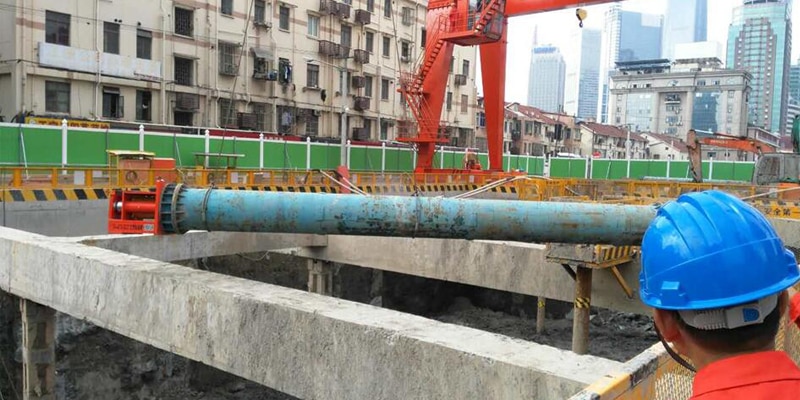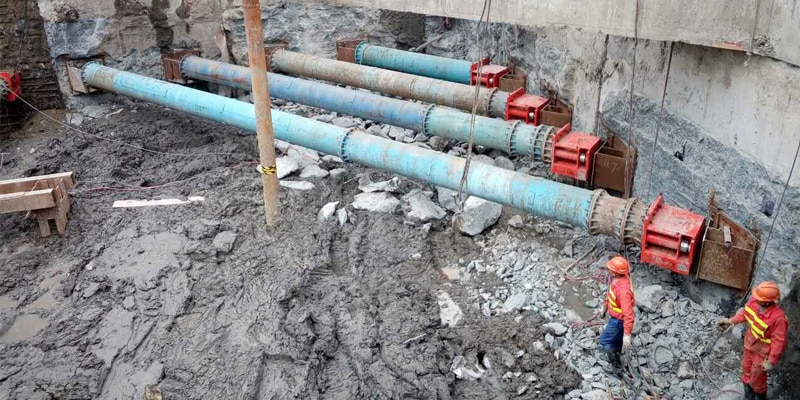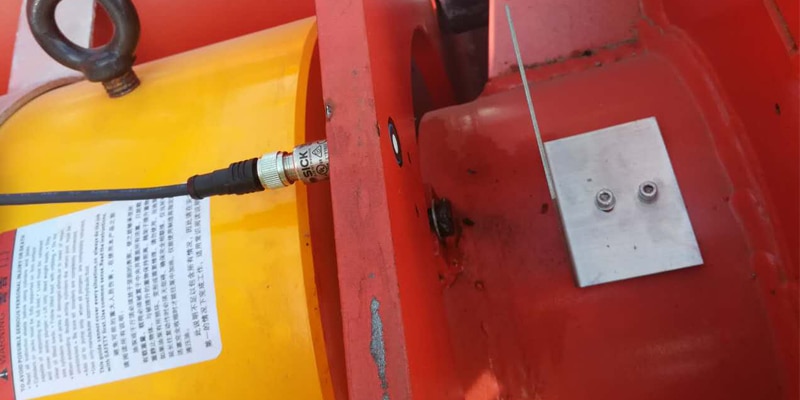Excavating construction and foundation pits is an essential stage in all kinds of construction projects, from building underground tunnels for traffic to erecting buildings or bridges. These projects are often associated with long lead times, during which the pit walls are exposed to numerous influences that can jeopardize their stability. Hydraulic support struts equipped with ultrasonic sensors and pressure transmitters from SICK ensure that the walls remain stable throughout the entire project.

There is a whole list of factors that can affect the stability of pit walls: incessant rain, ground frost, long spells of sunshine and dry conditions, problems with the soil structure, and vibrations caused by traffic and pile driving. In principle, support struts are an effective method of preventing soil slippage or even the pit walls collapsing altogether. Once they are installed in the pit, however, they are exposed to fluctuating seasonal temperatures and other external factors, causing them to expand or contract – and diminishing the level of support they provide as a result. Toehold Civil Engineering Technology Co., Ltd. in Shanghai has tackled this challenge head-on by developing support struts featuring hydraulic length adjustment.
The concept: An intelligent support strut
Founded in 2010, Toehold is one of Shanghai’s most innovative forces in civil engineering. The company has already invented more than 20 solutions that make it possible to automate construction work, detect areas of damage, and provide reliable monitoring methods for building infrastructures. The intelligent support strut that it has now developed is another invention that is without equal. Its job is to ensure that the ideal level of supporting strength is applied at all times, whatever the conditions, and to feed this strength into the pit walls. A controllable hydraulic cylinder at one end of the support strut allows the strut length to be adjusted continuously without any loss of function. A UM18-2 Pro ultrasonic sensor from SICK measures the length of the travel path. This process prevents individual struts from coming loose – meaning no more time or money spent on replacing them, and no more costs associated with salvaging and repairing machinery and devices in the event of a pit wall collapsing.

Ultrasonic sensor operating principle ideal for harsh construction pit environments
When it came to developing the path measurement process for the hydraulic cylinder, Toehold opted for the ultrasonic operating principle. In the harsh conditions associated with construction projects, the foremost factor that needs to be considered is reliable operation in varying light conditions, as well as when humidity and dust are present. The high-frequency vibrations from the transducer membrane are a useful tool in preventing deposits, as they deliver a kind of self-cleaning effect. The integrated temperature compensation provided by the ultrasonic sensors from SICK ensures that the measurement accuracy remains consistently high – in every season and every type of weather.
UM18-2 Pro provides the ideal supporting load
The ultrasonic sensors from the UM18-2 product family impressed the Toehold engineers thanks to their compact design with a one-part M18 metal housing, as well as their outstanding mechanical robustness and measuring reliability. The UM18-2 Pro variant provides an extensive range of features including a teach-in analog output and background-noise suppression, which blocks out unwanted extraneous sound and creates the right conditions for stable measurement results in the process. Toehold configures the sensors by means of teach-in programming via a cable, something which also prevents any accidental adjustment at the construction site. The optional Connect+ visualization and configuration software makes tasks such as copying parameters from sensor to sensor a breeze – another of the UM18-2 Pro’s key advantages. This also means that the software provides support for integrating control methods.

At just 41 millimeters in length, the sensor is integrated flush into the front plate of the hydraulic unit, and performs measurements using a metal plate that acts as a reflector and is mounted on the moving support plate for the pit wall. The process of installing the intelligent support strut involves extending it until it comes into contact with the pit wall, and then pressing it against the wall with a consistent level of pressure. If the length of the support strut changes, so too does the distance between the sensor and the metal plate – at which point the hydraulic unit is retracted or extended as appropriate. Toehold uses a PBT pressure transmitter from SICK for regulating system pressure. This sensor is also designed to deliver the ultimate in robustness and features a welded-on, hermetically sealed stainless-steel membrane. The sensor itself contains no mechanically moving parts, making it wear-free, fatigue-free, and maintenance-free.
The combination of UM18-2 Pro and PBT sensor technology enables automated control of the hydraulic actuators. As a result, the intelligent support strut from Toehold ensures that the walls of construction and foundation pits remain constantly stable – even in long-running construction projects.
Related Posts:
Long range distance sensors put to impressive use
Port of Tallinn moves to automated traffic flow management


